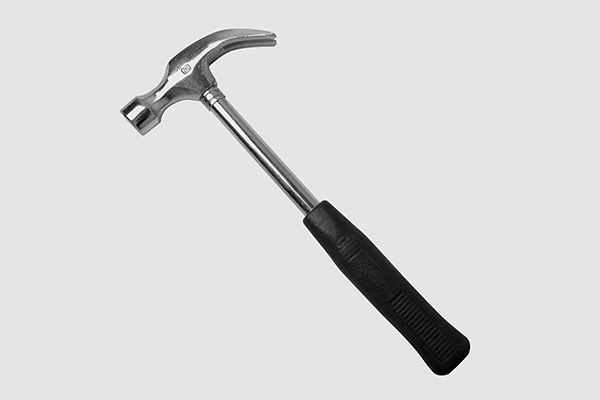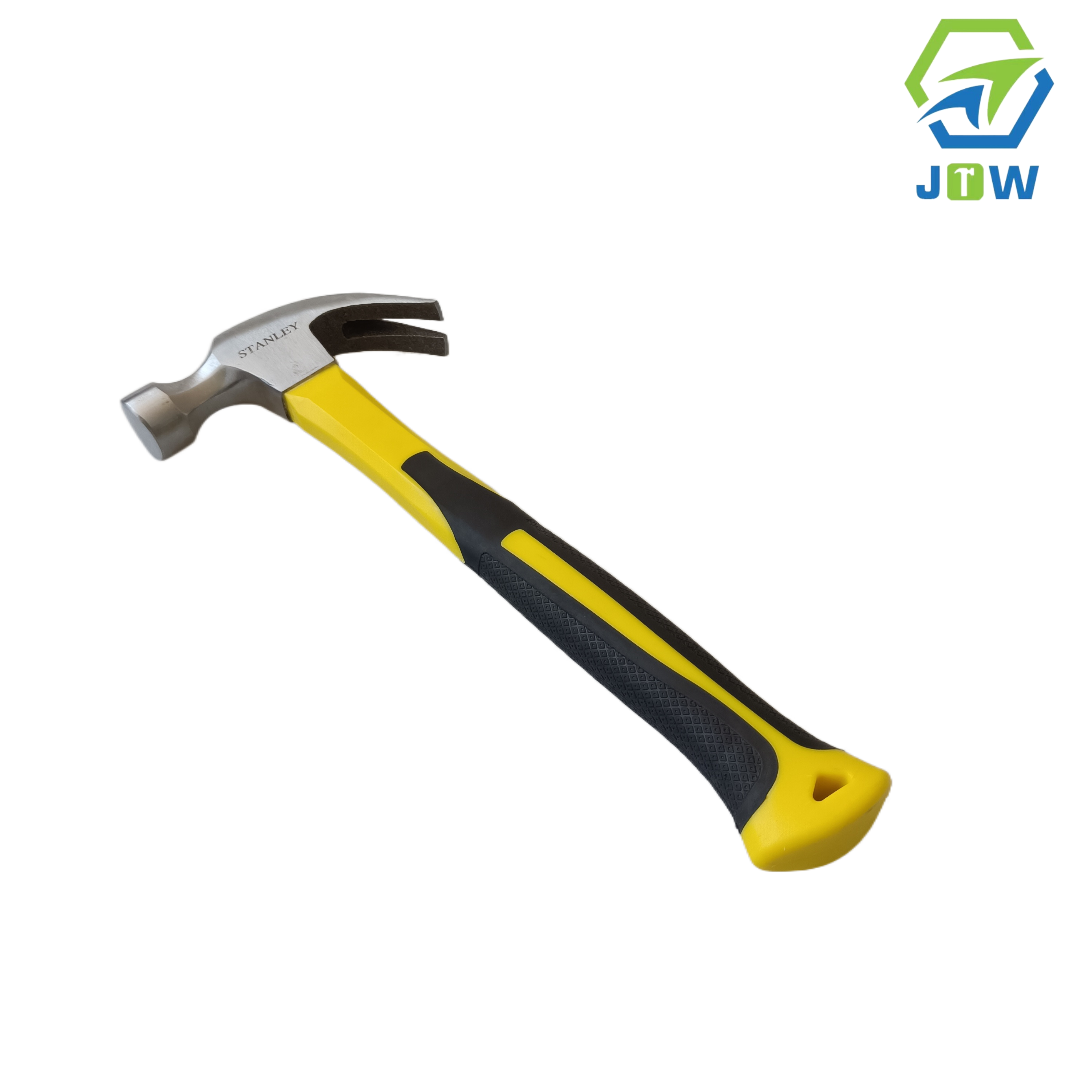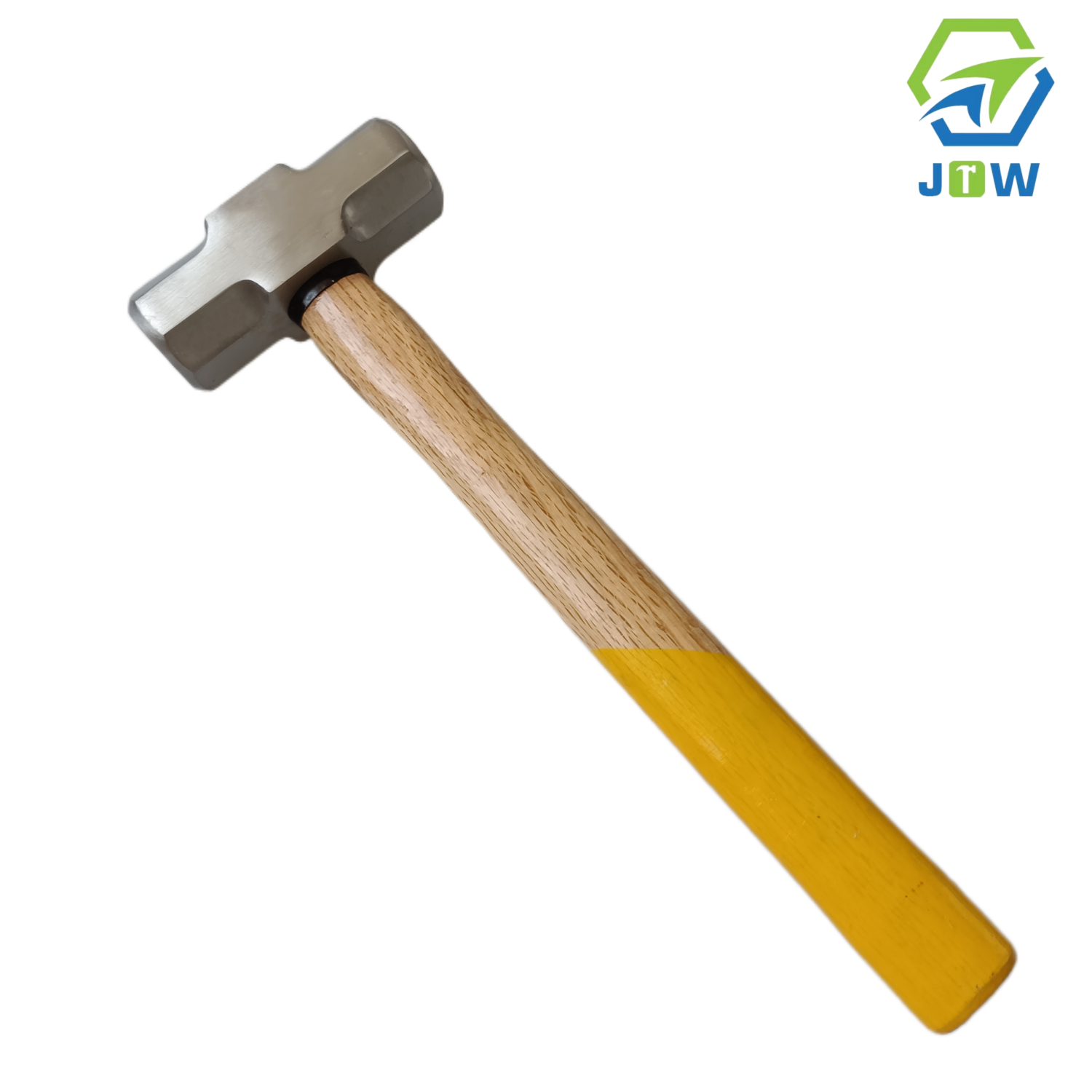Hi there! I'm Allen, and I run a factory in China where we make all sorts of hammers and axes. For years, we've been sending our tools to places like the USA, North America, Europe, and Australia. I've talked to many folks, like Mark Thompson, a business owner in the USA who buys tools for construction companies and hardware stores. Mark knows what he wants: good quality tools that last, but also at a fair price. This article is your friendly guide to understanding steel hammers, especially the popular 22 oz hammer with a milled face. We'll look at why these tools are key for many jobs, from big construction projects to home fixes. You'll learn what to look for in a quality hammer, making sure your next tool is up to the task and a great value. This is worth reading because choosing the right hammer makes your work easier, safer, and more efficient! We want you to feel confident when you pick your next hammer.
What Exactly is a Steel Hammer and Why is it Such a Popular Product?
A steel hammer is one of the most basic yet essential hand tools you'll find in any toolbox. But what makes it a steel hammer? Well, the head of the hammer, the part that does the hitting, is made of strong steel. This steel is often heat-treated, which is a special heating and cooling process. This makes the steel very hard and tough, so it can hit things many times without breaking or getting damaged easily. Think about it – a hammer needs to be strong to drive a nail into wood or even break things apart in demolition work.
Why is this tool so popular? It's because a steel hammer is incredibly versatile. You can use it for so many different tasks. Carpenters use them to build houses, mechanics use them for repairs, and even at home, you might use one to hang a picture. The design is simple: a heavy head on one end of a handle. This simple design has been around for centuries, and it still works great! It’s a fundamental product for anyone who builds or fixes things. At our factory, we make thousands of steel hammers every year, and they go to people all over the world because everyone needs a good hammer.
The popularity also comes from its reliability. A well-made steel hammer can last for many, many years. The steel head can withstand a lot of impact. When buyers like Mark are looking for tools, they want something dependable. A steel hammer is often the first tool someone buys when they start a project, and it’s usually the tool they depend on the most. It's a straightforward, effective tool that gets the job done, making it a top choice for professionals and DIYers alike.
Hammer Weight Matters: Is a 22 oz Steel Hammer the Right Choice for Your Work?
When you pick up a hammer, one of the first things you'll notice is its weight. Hammers come in different weights, usually measured in ounces (oz) or grams. For steel hammers used in construction, common weights range from 16 oz to 32 oz. So, what about a 22 oz steel hammer? Is that a good choice for your work? A 22 oz hammer is often considered a great all-around weight for general framing and construction tasks.
A 22 oz hammer provides a good balance between power and control. It's heavy enough to drive large nails into tough materials with fewer swings, which can save you energy and time. If you're doing a lot of framing work, where you're constantly driving 3-inch or 4-inch nails, a 22 oz hammer has the heft you need. However, it's not so heavy that it becomes tiring to use all day, especially if you're used to swinging a hammer. For someone doing a lot of overhead work, even a few extra ounces can make a difference, but for most framing applications, 22 oz hits a sweet spot.
The right hammer weight really depends on the type of work you do and your own strength. A lighter hammer (like 16 oz) might be better for smaller nails or for people who prefer less weight for prolonged use. Heavier hammers (28 oz or more) are typically for heavy-duty framing or demolition. The 22 oz steel hammer is a very popular choice because it offers a good compromise. It’s powerful enough for most common construction jobs but still manageable for many users. Many professionals find it’s the ideal tool for their daily tasks.

The All-Important Hammer Face: Smooth vs. Milled Face – What’s the Difference for Nailing?
The face of the hammer is the part that strikes the nail. Hammer faces typically come in two main types: smooth and milled. A smooth face hammer is, as the name suggests, flat and polished. This type of face is great for finish work, like installing trim or cabinetry. Why? Because if you accidentally hit the wood surface instead of the nail, a smooth face is less likely to leave a mark or damage the wood. It drives the nail cleanly.
A milled face hammer, on the other hand, has a textured pattern on its face, almost like a waffle. This pattern is designed to grip the head of the nail. This is a big advantage when you're doing framing work, especially if you're driving nails at an angle or in awkward positions. The milled face helps prevent the hammer from slipping off the nail head. This means you can swing with more confidence and power. A 22 oz steel hammer with a milled face is a common sight on construction sites, especially for building the frame of a house.
So, which one should you use? If you're doing rough framing, where the appearance of the wood isn't the main concern and you need to drive a lot of nails quickly and securely, a milled face hammer is often preferred. It can really speed up your work. However, that textured face will leave a distinct waffle-like mark on the wood if you miss the nail. For tasks where the finish matters, a smooth face is the way to go. Many carpenters will have both types of hammers in their tool collection to suit different jobs. The choice really depends on the specific application and the desired finish.
Beyond the Face: What Fine Details Define a Superior Quality Hammer?
When you're looking at a hammer, the face and weight are important, but there are other fine details that separate a good hammer from a great one. One of these is balance. A well-balanced hammer feels comfortable in your hand and allows for a more controlled and efficient swing. The weight should be distributed in a way that the hammer doesn’t feel too top-heavy or awkward. This is something we pay a lot of attention to in our factory because it directly affects how the user experiences the tool.
Another crucial detail is the quality of the steel used for the head and how it's treated. High-carbon steel is often used because it can be hardened to a higher level of toughness. The tempering process, which involves heating and cooling the steel under controlled conditions, is also vital. Proper tempering ensures the face is hard enough to resist deforming but not so brittle that it chips. The claw of the hammer (if it's a claw hammer) also needs to be strong and well-shaped for pulling nails effectively.
Other fine details include the precision of the head-to-handle connection. A loose hammer head is dangerous and inefficient. The overall finish of the tool, the smoothness of the metal, and the absence of sharp edges also indicate good craftsmanship. These might seem like small things, but they add up to a hammer that is safer, more durable, and more pleasant to use. For buyers like Mark, these are the kinds of quality indicators that they look for, as it means the product will perform well and last longer. We even consider features like a magnetic nail starter on some models, which is a small slot that holds a nail so you can start it with one hand.
What's the "Boss" on a Hammer and How Does It Improve the Tool?
You might hear the term "boss" when people talk about certain parts of a hammer, especially around the striking face or the area where the handle meets the head. In a general sense, a "boss" can refer to a raised or thickened area designed to add strength or provide a specific function. For example, some hammers have a more pronounced or reinforced striking face, and this entire striking surface might be what some refer to when they say "boss". This extra material or specific shaping can help the hammer withstand greater impact forces and reduce wear over time.
The design of the striking face, or the boss, is critical. On a milled face hammer, the pattern on the boss helps grip the nail. The precision of this milling is important. If the boss is well-made, it helps you drive nails more accurately and with less chance of the hammer glancing off. Some specialized hammers might have an oversized boss or striking face for specific tasks, allowing for a larger contact area and potentially more force to be delivered.
Ultimately, any feature called a "boss" on a hammer is usually there to enhance its performance or durability. It's part of the overall design that aims to make the tool more effective for its intended use. Whether it’s a slightly larger striking surface for better energy transfer or reinforced areas for longevity, these design elements contribute to the hammer's ability to handle tough jobs. When we make hammers, every part of the head, including the striking face or boss, is carefully engineered and tested.
Choosing Your Go-To Hammer: Ideal Features for General Construction and DIY Projects.
For general construction and most DIY projects, a claw hammer is usually the most versatile and ideal choice. The "claw" part is the V-shaped split on the back of the head, which is perfect for pulling out nails. Within claw hammers, you'll then consider the weight and face type, as we've discussed. A 22 oz steel hammer with a molded face is excellent for framing and rough carpentry, while a 16 oz smooth face hammer is better suited for lighter tasks and finish work.
What other features should you look for? A good grip is essential. The handle should feel comfortable and secure in your hand, even if you're wearing gloves. Look for materials that absorb shock, like fiberglass or a well-designed TPR (thermoplastic rubber) grip over a steel or fiberglass handle. This can reduce the vibration you feel in your arm, making the hammer more comfortable to use for longer periods. We've found that an ergonomically designed 16 Ounce Claw Hammer Anti-Vibration Handle and Drop Forged Steel Head can make a big difference in user comfort.
Consider the overall build quality. The hammer head should be securely attached to the handle. Forged steel heads are generally more durable than cast ones. Look for a hammer that feels solid and well-balanced. For many DIYers, a good quality 16 to 20 oz claw hammer will cover most needs. For those tackling bigger projects or more frequent construction work, investing in a robust 22 oz steel hammer can be a wise decision. The key is to pick a tool that matches the kind of work you'll be doing most often.

Why is the Handle So Crucial for a Hammer's Performance and User Comfort?
The handle of a hammer is much more than just something to hold onto; it’s a critical component that affects performance, safety, and comfort. A good handle design helps absorb the shock of each impact, reducing the strain on your hand, wrist, and arm. This is especially important if you're using the hammer for extended periods. Materials like hickory wood have natural shock-absorbing qualities and have been a traditional choice for hammer handles for a long time.
Modern hammers often feature handles made from fiberglass or steel, often with an ergonomic rubber or synthetic grip. Fiberglass handles are strong, lightweight, and can be very effective at dampening vibrations. Steel handles are extremely durable but can transmit more shock if not well-designed with a good grip. The shape of the handle is also important. An ergonomically designed handle will fit your hand more comfortably, providing better control and reducing fatigue. Some handles have a contoured grip or a slight curve to improve the swing.
When we design and make hammers at our factory, a lot of thought goes into the handle. We consider the material, the shape, the grip texture, and how it balances with the head. A well-designed handle not only makes the tool more comfortable but also allows the user to transfer energy more efficiently to the nail. For someone like Mark, who purchases tools for resale, knowing that the hammers have high-quality, comfortable, and durable handles is a key selling point, as it directly impacts the end-user's experience.
From Our Factory Floor: How Do We Ensure Top Quality in Every Hammer We Make? (My Perspective as Allen)
As a factory owner, my name is Allen, and ensuring top quality in every hammer we make is my number one priority. It's not just about making a product; it's about crafting a reliable tool that people can depend on. This starts with the materials. We source high-grade steel for the hammer heads. This steel needs to have the right carbon content to achieve the desired hardness and toughness after heat treatment. For handles, whether it's American hickory, strong fiberglass, or tubular steel, we select materials known for their durability and performance.
The manufacturing process itself involves many quality control checkpoints. From forging the steel hammer heads to precisely milling the faces and securely attaching the handles, each step is monitored. Our heat treatment process is carefully calibrated to ensure the striking face is exceptionally hard to resist wear, while the eye (the hole where the handle fits) is kept slightly softer to prevent cracking. We conduct regular tests, such as hardness tests on the hammer heads and strength tests on the handle assembly. We also pay close attention to the balance and feel of each hammer. It's this attention to detail that helps us produce a durable and effective tool.
Meeting international standards is also a big part of our quality commitment. Buyers like Mark Thompson from the USA need assurance that the tools they import are safe and meet industry specifications. We work to ensure our hammers comply with relevant standards, and we are transparent about our testing processes. This commitment to quality helps build trust and long-term relationships with our customers. We understand that a good hammer is an investment, and we want every tool that leaves our factory to be a testament to good craftsmanship. We are proud of the hammers we produce, knowing they will help people build and create.

What Popular Hammer Types Should Be in Every Professional's and Retailer's Product Line-Up?
For professionals and hardware retailers like Mark's customers, having a good range of popular hammer types is essential to meet diverse needs. The most common, as we've discussed, is the claw hammer. This is the workhorse for most carpentry and general household tasks. Retailers should stock various weights (e.g., 8 oz for light work, 16 oz for general use, and 20-22 oz for framing) and face types (smooth and milled). A Mini claw hammer 8 oz is great for tight spaces or smaller jobs.
Beyond the claw hammer, other important types include:
- Sledge Hammers: These are heavy-duty hammers with large, flat heads, designed for demolition work, driving stakes, or breaking concrete. They come in various weights, from a few pounds up to 20 pounds or more. A sledge hammer 2lb-20lb fiberglass handle offers a good range.
- Ball Peen Hammers: These have one flat striking face and one rounded (peen) face. They are primarily used for metalworking, such as shaping metal, rounding rivets, or closing G. Offering a 45# high carbon steel forged high hardness Ball pein hammer with fiberglass handle would be a good addition.
- Rubber Mallets: These have a rubber head and are used when you need to apply force without damaging the surface, like in woodworking, tiling, or assembling furniture.
- Machinist Hammers: These are similar to ball peen hammers but can also include cross peen or straight peen designs. They are precision tools for engineering and metal fabrication tasks. A good quality Machinist Hammer is a must for certain trades.
Having a selection of these popular hammer types ensures that customers can find the right tool for their specific job. As a manufacturer, we produce all these types, focusing on the quality and durability that professionals and serious DIYers expect from their hand tools. This variety is key for any retailer aiming to be a one-stop shop for tools.
Keeping Your Steel Hammer in Top Shape: Essential Maintenance and Safety Tips.
A good steel hammer is a tough tool, but a little care can make it last even longer and keep it safe to use. One of the most important things is to keep the hammer clean and dry. After use, wipe off any dirt, debris, or moisture. This helps prevent rust, especially on the steel head. If your hammer has a wooden handle, avoid storing it in overly damp or dry conditions, as this can cause the wood to swell or shrink, potentially loosening the head.
Inspect your hammer regularly for any signs of damage. Check the striking face for any chips, cracks, or excessive wear. If the face is damaged, it might be time to replace the hammer, as using a damaged face can be unsafe – chips of metal could fly off. For claw hammers, ensure the claw isn't bent or broken. Also, always check that the hammer head is securely attached to the handle. If it's loose, don't use it until it's properly fixed or replaced. A flying hammer head is extremely dangerous!
Safety is paramount when using any tool, especially a hammer. Always wear safety glasses to protect your eyes from flying debris or nail fragments. Make sure your swing path is clear and that no one is standing too close. Use the right hammer for the job – don't use a claw hammer to strike hardened steel, for example, as this can damage the hammer face or cause chipping. By following these simple maintenance and safety tips, you can ensure your steel hammer remains a reliable and safe tool for many years of work. This attention to detail in tool care is something we always try to communicate to users.
The Future of Hammers: Are There New Innovations and Popular Trends in Hammer Design?
You might think a tool as old as the hammer wouldn't change much, but there are always innovations happening! The latest trends in hammer design often focus on improving ergonomics, reducing vibration, and increasing efficiency. For example, we're seeing more hammers with advanced anti-vibration technology built into the handle. This can significantly reduce the impact felt by the user, making the tool more comfortable for all-day use and potentially reducing the risk of repetitive strain injuries.
Materials science also plays a role. While high-carbon steel remains a top choice for heads, manufacturers are constantly exploring new alloys and treatments to enhance durability and performance. For handles, alongside traditional wood and fiberglass, you might find hammers with composite handles or innovative grip designs that offer better control and comfort. Some hammers even incorporate features like built-in magnetic nail holders, which allow for one-handed nail starting, or unique claw designs for better nail pulling and prying.
Another trend is the development of more specialized hammers for specific tasks. While the general-purpose claw hammer will always be popular, you might see more refined designs for particular trades, like electricians' hammers or roofing hammers with specific features tailored to their needs. As a factory, we keep an eye on these latest developments and listen to feedback from users like Mark and the professionals he supplies. This helps us to continue making hammers that are not only durable and reliable but also incorporate features that make the work of the user easier and more productive. The good old hammer is still evolving!
Key Takeaways: Choosing and Using Your Steel Hammer
Here’s a quick summary of what to remember about steel hammers:
- Steel hammers are essential, versatile tools made with hardened steel heads for durability.
- A 22 oz hammer is a popular weight for general construction and framing, offering a good balance of power and control.
- The hammer face can be smooth (for finish work) or milled (for better nail grip in framing).
- Fine details like balance, steel quality, and handle design significantly impact a hammer's performance and longevity.
- The "boss" or striking area is designed for strength and effective impact.
- For general use, a claw hammer is often the ideal choice; consider features like shock absorption in the handle.
- Handle material (fiberglass, wood, steel) and ergonomic design are crucial for comfort and reducing fatigue.
- Quality manufacturing involves good materials, precise processes, and adherence to standards – something we prioritize.
- A good toolkit includes various hammer types like claw, sledge, ball peen, and rubber mallets.
- Regular maintenance (cleaning, inspection) and safe usage (eye protection, proper swing) are vital.
- Hammer design continues to evolve with innovations in materials, ergonomics, and specialized features.
Thank you for reading! I hope this guide helps you understand steel hammers better and choose the right tool for your needs. If you ever have questions about hammers or axes, remember folks like me are always working to make the best tools for your job.
Post time: 05-13-2025





